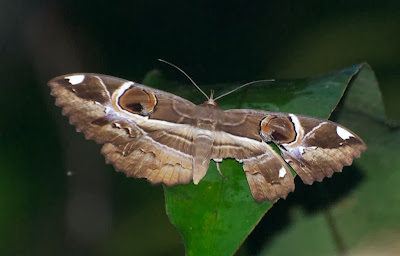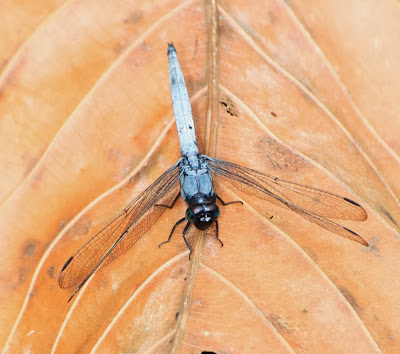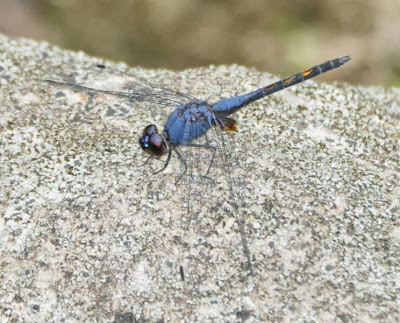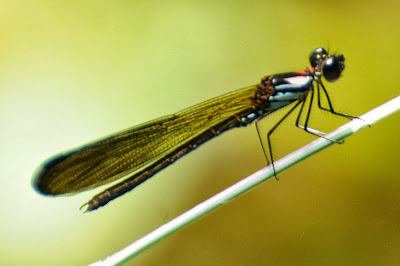When night fell during our October 2012 course for birding guides at Kubah National Park, we were free to don our headlamps and scout around for the nocturnal inhabitants of the forest (not, I fear, including night birds). Our chief target was the frog pond and the boardwalk around it, but the frogs themselves deserve their own post and will get it (well, two posts, actually, as you will see). Here I will concentrate on the non-frogs,some of which were day-flying insects simply trying to get a night's sleep. This is one of them, a Banded Marquis (Euthalia [or Bassarona] teuta bellata), a butterfly I have never been sure of seeing by day. Here it is, though.
We were more likely to turn up genuine night-haunters, like this katydid nymph....
...or one of Borneo's spectacular stick insects.
This peculiar object appears to be an ant colony (or, at least, it has attracted one).
Moths were conspicuous (thanks to their particularly bright eyeshine), abundant, and diverse.
I would love to be able to tell you what these are, but my attempts at identification have proved sorry failures. Can anyone help?
It is particularly galling not to be able to name a moth as large and spectacular (even if damaged) as this one, though I suspect it is some sort of silk moth (Saturniidae).
I feel less guilty about something like this nicely-camouflaged moth (well, it would be nicely camouflaged on a tree) on the wall of the park headquarters.
This little green moth is quite common, but once again all I have been able to find are photographs of, presumably, the same species on the internet, unhelpfully labelled "green moth".
As happens almost everywhere in the humid tropics, lit-up walls attracted geckos (or, perhaps better, it attracted insects which the geckos ate). This one is a Spotted House Gecko (Gekko monarchus).
Back in the forest near the frog pond, I came across this extremely attractive snail navigating through the shrubbery at, fortunately, eye level.
My thanks to Gary Rosenberg for identifying this little beauty as as Leptopoma undatum. Leptopoma is an operculate snail, meaning it has an operculum, a horny plate it can use to seal off the opening of its shell (it's the object resembling a large fingernail sticking out of the back of the shell). The species is endemic to northern Borneo.
Nocturnal mammals are not easy to come across in Borneo. I was delighted when we came across this one on the roadside just across from the frog pond, even if it was only a mouse.
Mind you, when I say "only" I am being rather facetious. It is, in fact, not just any mouse but a Pencil-tailed Tree Mouse, one of three very similar Bornean rainforest mice in the south-east Asian genus Chiropodomys. Notice the brush-like (or "pencil-like") tip to the tail. Also notice the very long tail and immense faceful of whiskers, both presumably adaptations for balancing and feeling one's way through the trees.
Of course I wanted to know which of the three Bornean species this one might be, so I wrote Quentin and Karen Phillips. Their view is that, of the three Bornean species, this is either the Small (or Common, or Lesser) Pencil-tailed Tree Mouse (Chiropodomys pusillus) or the Large (or Greater) Pencil-tailed Tree Mouse (Chiropodomys major) (the third species is known only from Mount Kinabalu in Sabah). The two differ mostly by size, and you can't tell that from a photo (except that the Lesser prefers bamboo, and this one isn't in bamboo, so the Greater may be the more likely). Not surprisingly, not much seems to be known about either of them.
Anyway, it was a delightful little animal, and a highlight of our weekend in Kubah.
Thursday, December 26, 2013
Wednesday, December 25, 2013
Sarawak: Training at Kubah
Back in 2011, I had the opportunity to make a pitch for increased birding tourism in Sarawak to the tourism industry and to the state ministry. I'm glad to say that it went rather well, and a year later I found myself asked to be one of the leaders in a first-ever training course for birding guides, to be held at Kubah National Park on October 5-7, 2012. We had the participation of some fine birders, including Daniel Kong (on the right, above), and an unofficial visit from the Sarawak Forestry Corporation in the person of Oswald Braken Tisen (next to Daniel).
The course went well, though in retrospect I am not sure that plunging first-time birders into a rainforest (as opposed to, say, an open area such as Chupak) was ideal. Getting decent looks at rainforest birds can be tough.
It helps, of course, if the bird you are looking at is difficult to mistake for anything else. This is not an ideal photograph, but it could be nothing else but a male Asian Paradise Flycatcher (Terpsiphone paradisi).
A better example of some of the difficulties involved is this rather distant (cropped) shot of a Dark-sided Flycatcher (Muscicapa sibirica), a migrant from northern Asia. There are a lot of things you could mistake this for. By the way, despite the fact that this and the previous species are both called flycatchers, they are only distantly related. The Paradise Flycatcher is a member of the largely Australasian monarch family (Monarchidae), rather than a "true" flycatcher like this bird, a member of the largely Eurasian and African flycatcher/chat family Muscicapidae.
This bird, a male Red-naped Trogon (Harpactes kasumba), is easy to identify to family (and spectacular even when it chooses to remain partially hidden among the branches), but seeing enough of it to be sure of the species can be tricky. In this case, the bright blue skin around the eye (when you can see the eye, that is) is helpful in pinning it down.
Birds, of course, are still a lot easier for a beginner to identify than rainforest plants. I have shown this one before here, but I am still waiting for someone to tell me what it is.
These particularly bright red shoots belong to some sort of ginger.
I assume that this little butterfly, making his (or her) escape just as I press the shutter, is some sort of blue (Lycaenidae).
Kubah has plenty of tiny stingless bees. They are easiest to see at their colonies, but here are a few visiting a flower.
The park is also rich in dragonflies, and I took an opportunity to chase a few during breaks in the course. Here are a couple of common species, Orthetrum chrysis...
...and Orthetrum glaucum.
The brilliantly-metallic Cratilla metallica is common at Kubah too.
Not so common, but easy to find at the well-known frog pond off the main paved road into the park, is Tyriobapta torrida, known as "Treehugger" in Singapore because of its habit of perching vertically on tree trunks. These are males, very different-looking insects from the mottled brown females, and much less capable of camouflaging themselves against a patch of bark. Around the pond, though, territory beats out concealment. Males are quite conspicuous as they patrol the pond edge.
The murky waters of the pond can sometimes turn up a surprise. This is a Malayan softshell turtle (Dogania subplana), a species that prefers forest streams to ponds. It may (according to Indraneil Das, who kindly confirmed my ID) have dropped by the pond from a nearby stream about 10 metres away. I had written about this species and its peculiarities in my book Turtles, Tortoises and Terrapins: A Natural History, but this was my first encounter with it in the wild.
Dogania has an unusually large head, a feature that presents it with difficulties should it need to withdraw into its shell. In consequence, its shell is one of the most flexible in all turtles, a feature first reported by Peter Pritchard of the Chelonian Research Institute. Every bone in its carapace is free to move independently - a modification found in no other turtle - and when the turtle needs to withdraw its head and neck, the whole shell can bulge to make room.
The course went well, though in retrospect I am not sure that plunging first-time birders into a rainforest (as opposed to, say, an open area such as Chupak) was ideal. Getting decent looks at rainforest birds can be tough.
It helps, of course, if the bird you are looking at is difficult to mistake for anything else. This is not an ideal photograph, but it could be nothing else but a male Asian Paradise Flycatcher (Terpsiphone paradisi).
A better example of some of the difficulties involved is this rather distant (cropped) shot of a Dark-sided Flycatcher (Muscicapa sibirica), a migrant from northern Asia. There are a lot of things you could mistake this for. By the way, despite the fact that this and the previous species are both called flycatchers, they are only distantly related. The Paradise Flycatcher is a member of the largely Australasian monarch family (Monarchidae), rather than a "true" flycatcher like this bird, a member of the largely Eurasian and African flycatcher/chat family Muscicapidae.
This bird, a male Red-naped Trogon (Harpactes kasumba), is easy to identify to family (and spectacular even when it chooses to remain partially hidden among the branches), but seeing enough of it to be sure of the species can be tricky. In this case, the bright blue skin around the eye (when you can see the eye, that is) is helpful in pinning it down.
Birds, of course, are still a lot easier for a beginner to identify than rainforest plants. I have shown this one before here, but I am still waiting for someone to tell me what it is.
These particularly bright red shoots belong to some sort of ginger.
I assume that this little butterfly, making his (or her) escape just as I press the shutter, is some sort of blue (Lycaenidae).
Kubah has plenty of tiny stingless bees. They are easiest to see at their colonies, but here are a few visiting a flower.
...and Orthetrum glaucum.
The brilliantly-metallic Cratilla metallica is common at Kubah too.
Not so common, but easy to find at the well-known frog pond off the main paved road into the park, is Tyriobapta torrida, known as "Treehugger" in Singapore because of its habit of perching vertically on tree trunks. These are males, very different-looking insects from the mottled brown females, and much less capable of camouflaging themselves against a patch of bark. Around the pond, though, territory beats out concealment. Males are quite conspicuous as they patrol the pond edge.
The murky waters of the pond can sometimes turn up a surprise. This is a Malayan softshell turtle (Dogania subplana), a species that prefers forest streams to ponds. It may (according to Indraneil Das, who kindly confirmed my ID) have dropped by the pond from a nearby stream about 10 metres away. I had written about this species and its peculiarities in my book Turtles, Tortoises and Terrapins: A Natural History, but this was my first encounter with it in the wild.
Dogania has an unusually large head, a feature that presents it with difficulties should it need to withdraw into its shell. In consequence, its shell is one of the most flexible in all turtles, a feature first reported by Peter Pritchard of the Chelonian Research Institute. Every bone in its carapace is free to move independently - a modification found in no other turtle - and when the turtle needs to withdraw its head and neck, the whole shell can bulge to make room.
Sunday, December 22, 2013
Sarawak: Damselflies at the Tea Room
For the Sunday portion of the 2012 Sarawak Nature Festival (September 30, 2012), Sue Teal took the children (including Ryan, in hat) out for some nature-viewing activities outside the Chinese Tea Room at Borneo Highlands.
While the children were busy, the birders took up their posts behind the tea room to wait for Pygmy White-Eyes (Oculocincta squamifrons), an area specialty.
I decided, instead, to explore for damselflies in the rocky stream bed just below the white-eye-watching spot. Damselflies, though, weren't the only insects to visit the damp rocks along its banks: here is a Common Eggfly (Hypolimnas bolina).
Trithemis dragonflies seemed particularly attracted to the vicinity of the streambed. This is Trithemis aurora.
Here is Trithemis festiva, demonstrating why it bears the English name "Indigo Dropwing". The wings-down-and-forward posture is typical.
These almost-golden dragonflies had me stumped, but according to Borneo odonate expert Rory Dow they are simply immature males of the common Orthetrum glaucum.
This striking insect is a male of another common species, Neurothemis ramburii.
I found three species of damselfly in the stream bed, and because the taxonomy of these insects in Sarawak is so unsettled I sent photos of the lot to Rory Dow for his comments. This one is a member of the genus Euphaia, but which species?
Rory commented: "I think that the Euphaea is E. subcostalis - subcostalis and tricolor are very similar and difficult to tell apart in photos, but the shape of the wing marking and a few other details lead me to subcostalis, plus it is the only Euphaea I found at Borneo Highlands." That's good enough for me, so a nearly-certain Euphaea subcostalis it is.
This one, a member of the short-bodied family Chlorocyphidae, is Heliocypha biseriata - though Rory notes that this species may have to be combined with another, Heliocypha biforata, a species I have seen in West Malaysia.
Finally, this beautiful little sprite - difficult to spot amid the vegetation despite its bright colours - is Prodasineura verticalis. My thanks, once again, to Rory Dow for helping me to learn a little more about these fascinating creatures!
While the children were busy, the birders took up their posts behind the tea room to wait for Pygmy White-Eyes (Oculocincta squamifrons), an area specialty.
I decided, instead, to explore for damselflies in the rocky stream bed just below the white-eye-watching spot. Damselflies, though, weren't the only insects to visit the damp rocks along its banks: here is a Common Eggfly (Hypolimnas bolina).
Trithemis dragonflies seemed particularly attracted to the vicinity of the streambed. This is Trithemis aurora.
Here is Trithemis festiva, demonstrating why it bears the English name "Indigo Dropwing". The wings-down-and-forward posture is typical.
These almost-golden dragonflies had me stumped, but according to Borneo odonate expert Rory Dow they are simply immature males of the common Orthetrum glaucum.
This striking insect is a male of another common species, Neurothemis ramburii.
I found three species of damselfly in the stream bed, and because the taxonomy of these insects in Sarawak is so unsettled I sent photos of the lot to Rory Dow for his comments. This one is a member of the genus Euphaia, but which species?
Rory commented: "I think that the Euphaea is E. subcostalis - subcostalis and tricolor are very similar and difficult to tell apart in photos, but the shape of the wing marking and a few other details lead me to subcostalis, plus it is the only Euphaea I found at Borneo Highlands." That's good enough for me, so a nearly-certain Euphaea subcostalis it is.
This one, a member of the short-bodied family Chlorocyphidae, is Heliocypha biseriata - though Rory notes that this species may have to be combined with another, Heliocypha biforata, a species I have seen in West Malaysia.
Finally, this beautiful little sprite - difficult to spot amid the vegetation despite its bright colours - is Prodasineura verticalis. My thanks, once again, to Rory Dow for helping me to learn a little more about these fascinating creatures!
Subscribe to:
Posts (Atom)
![Banded Marquis (Euthalia [Bassarona] teuta bellata) Banded Marquis (Euthalia [Bassarona] teuta bellata)](https://blogger.googleusercontent.com/img/b/R29vZ2xl/AVvXsEgmxcBWmJ0FkaKu-GcFLHOc5Ea1KrYZeOFyBcezdlEr4WKBPg3G1Ew2vc-ExRVB3yScf88cL688zM_H728Wqx8YlrnoqwTFeh3VplimdoNR6JPpwV3PDDHXdnRQiRuTuy8JEtcz67hduwix/s400/Banded+Marquis+(Euthalia+%5BBassarona%5D+teuta+bellata)+DSC_4825.jpg)














+DSC_5122.jpg)
+DSC_5123.jpg)
+DSC_5118.jpg)
+DSC_5121.jpg)


+DSC_4974.jpg)
+DSC_4970.jpg)













+DSC_4949.jpg)
+DSC_4950.jpg)
+DSC_4951.jpg)


















